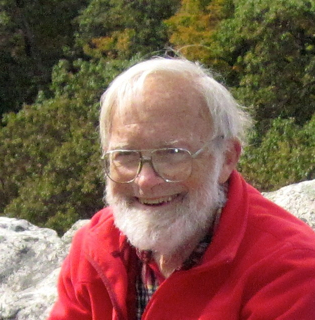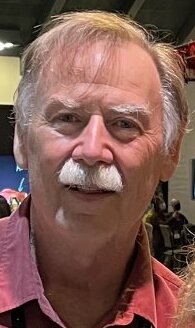
Donald R. Woods (born April 30, 1954) is an American hacker and computer programmer. He is best known for his role in the development of the Colossal Cave Adventure game.

Donald R. Woods (born April 30, 1954) is an American hacker and computer programmer. He is best known for his role in the development of the Colossal Cave Adventure game.
Woods teamed with James M. Lyon while both were attending Princeton in 1972 to produce the unprecedented, excursive INTERCAL programming language. Later, he worked at the Stanford AI lab (SAIL), where among other things he became the SAIL contact for, and a contributor to, the Jargon File. He also co-authored "The Hacker's Dictionary" with Mark Crispin, Raphael Finkel, and Guy L. Steele Jr. [1]
Woods discovered the Colossal Cave Adventure game by accident on a SAIL computer in 1976. After contacting the original author by the (now antiquated) means of sending an e-mail to crowther@sitename, where sitename was every host listed on ARPANET, he heard back from William Crowther shortly afterward.
Given the go-ahead, Woods proceeded to add enhancements to the Adventure game, and then distributed it on the Internet. It became very popular, especially with users of the PDP-10. Woods stocked the Kentucky cave that Crowther had written with new magical items, creatures, and geographical features. Crowther's game, which originally featured few supernatural elements, was transformed into a loose fantasy world featuring elements from role playing games. [2] Woods can thus, in a sense, be considered one of the progenitors of the entire genre of computer adventure games and interactive fiction.
By 1977 tapes of the game were common on the Digital user group DECUS, and others (see The Soul of a New Machine by Tracy Kidder for a human history of this period).
The terms foobar, foo, bar, baz, and others are used as metasyntactic variables and placeholder names in computer programming or computer-related documentation. They have been used to name entities such as variables, functions, and commands whose exact identity is unimportant and serve only to demonstrate a concept.

Interactive fiction, often abbreviated IF, is software simulating environments in which players use text commands to control characters and influence the environment. Works in this form can be understood as literary narratives, either in the form of interactive narratives or interactive narrations. These works can also be understood as a form of video game, either in the form of an adventure game or role-playing game. In common usage, the term refers to text adventures, a type of adventure game where the entire interface can be "text-only", however, graphic text adventures still fall under the text adventure category if the main way to interact with the game is by typing text. Some users of the term distinguish between interactive fiction, known as "Puzzle-free", that focuses on narrative, and "text adventures" that focus on puzzles.
A MUD is a multiplayer real-time virtual world, usually text-based or storyboarded. MUDs combine elements of role-playing games, hack and slash, player versus player, interactive fiction, and online chat. Players can read or view descriptions of rooms, objects, other players, non-player characters, and actions performed in the virtual world. Players typically interact with each other and the world by typing commands that resemble a natural language.
In computing, Xyzzy is sometimes used as a metasyntactic variable or as a video game cheat code. Xyzzy comes from the Colossal Cave Adventure computer game, where it is the first "magic word" that most players encounter.

Roguelike is a subgenre of role-playing computer games traditionally characterized by a dungeon crawl through procedurally generated levels, turn-based gameplay, grid-based movement, and permanent death of the player character. Most roguelikes are based on a high fantasy narrative, reflecting their influence from tabletop role playing games such as Dungeons & Dragons.

Rogue is a dungeon crawling video game by Michael Toy and Glenn Wichman with later contributions by Ken Arnold. Rogue was originally developed around 1980 for Unix-based minicomputer systems as a freely distributed executable. It was later included in the official Berkeley Software Distribution 4.2 operating system (4.2BSD). Commercial ports of the game for a range of personal computers were made by Toy, Wichman, and Jon Lane under the company A.I. Design and financially supported by the Epyx software publishers. Additional ports to modern systems have been made since by other parties using the game's now-open source code.

David Lance Arneson was an American game designer best known for co-developing the first published role-playing game (RPG), Dungeons & Dragons, with Gary Gygax, in the early 1970s. Arneson's early work was fundamental to the development of the genre, developing the concept of the RPG using devices now considered to be archetypical, such as adventuring in dungeons and using a neutral judge who doubles as the voice and consciousness of all characters aside from the player characters to develop the storyline.

Colossal Cave Adventure is a text-based adventure game, released in 1976 by developer Will Crowther for the PDP-10 mainframe computer. It was expanded upon in 1977 by Don Woods. In the game, the player explores a cave system rumored to be filled with treasure and gold. The game is composed of dozens of locations, and the player moves between these locations and interacts with objects in them by typing one- or two-word commands which are interpreted by the game's natural language input system. The program acts as a narrator, describing the player's location and the results of the player's attempted actions. It is the first well-known example of interactive fiction, as well as the first well-known adventure game, for which it was also the namesake.

Roberta Lynn Williams is an American video game designer and writer, who co-founded Sierra On-Line with her husband, game developer Ken Williams. In 1980, her first game, Mystery House, became a modest commercial success; it is credited as the first graphic adventure game. She is also known for creating and maintaining the King's Quest series, as well as designing the full motion video game Phantasmagoria in 1995.

William Crowther is an American computer programmer, caver, and rock climber. He is the co-creator of Colossal Cave Adventure from 1975 onward, a seminal computer game that influenced the first decade of video game design and inspired the text adventure game genre.

Adventure is a video game developed by Warren Robinett for the Atari Video Computer System and released in 1980 by Atari, Inc. The player controls a square avatar whose quest is to explore an open-ended environment to find a magical chalice and return it to the golden castle. The game world is populated by roaming enemies: three dragons that can eat the avatar and a bat that randomly steals and hides items around the game world. Adventure introduced new elements to console games, including a play area spanning multiple screens and enemies that continue to move when offscreen.

Joseph Warren Robinett Jr. is a designer of interactive computer graphics software, notable as the developer of the Atari 2600's Adventure — the first graphical adventure video game — and as a founder of The Learning Company, where he designed Rocky's Boots and Robot Odyssey. More recently he has worked on virtual reality projects.
Patricia ("Pat") P. Crowther, later known as Patricia P. Wilcox, is an American cave explorer and cave surveyor active in the 1960s and early 1970s. She also worked as a computer programmer.

Level 9 was a British developer of computer software, active between 1981 and 1991. Founded by Mike, Nicholas and Pete Austin, the company produced software for the BBC Micro, Nascom, ZX Spectrum, Commodore 64, Oric, Atari, Lynx 48k, RML 380Z, Amstrad CPC, MSX, Amiga, Apple II, Memotech MTX, and Enterprise platforms and is best known for its successful text adventure games until a general decline in the text adventure market forced their closure in June 1991.

Colossal Adventure is a text based adventure game published by Level 9 Computing in 1982. It was originally released for the Nascom.

Kenneth A. Williams is an American game programmer who co-founded On-Line Systems together with his wife Roberta Williams. On-Line Systems eventually became Sierra On-Line and was ultimately renamed Sierra Entertainment. The couple were leading figures in the development of graphical adventure games. At its height, Sierra employed nearly 1,000 people prior to its acquisition in 1996.

Marc Blank is an American game developer and software engineer. He is best known as part of the team that created one of the first commercially successful text adventure computer games, Zork.
A text game or text-based game is an electronic game that uses a text-based user interface, that is, the user interface employs a set of encodable characters, such as ASCII, instead of bitmap or vector graphics.
An adventure game is a video game genre in which the player assumes the role of a protagonist in an interactive story, driven by exploration and/or puzzle-solving. The genre's focus on story allows it to draw heavily from other narrative-based media, such as literature and film, encompassing a wide variety of genres. Most adventure games are designed for a single player, since the emphasis on story and character makes multiplayer design difficult. Colossal Cave Adventure is identified as the first such adventure game, first released in 1976, while other notable adventure game series include Zork, King's Quest, Monkey Island, Syberia, and Myst.

Wander is text adventure written by Peter Langston in 1974. It is one of the earliest text adventure video games in existence, predating Colossal Cave Adventure. The game was originally coded in BASIC on a mainframe computer with multiple databases to create the worlds that formed the game. It was distributed in Langston's PSL Games collection for Unix.